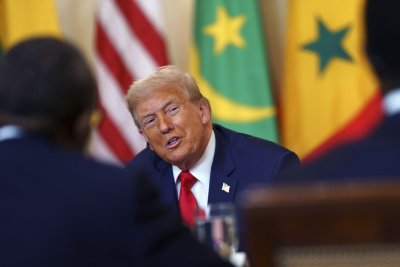
July 31 (UPI) — President Donald Trump‘s suspension of reciprocal tariffs ends Friday and the United States has only managed a small portion of his goal for new trade deals.
Trump has pushed back his self-imposed deadlines on multiple occasions during his second term but said in a post on social media on Wednesday that Friday’s deadline will not be extended.
A day after the post, Trump announced a 90-day pause on new tariffs on Mexico as trade negotiations continue.
The United States has reached preliminary trade deals with at least five countries, though these framework agreements lack some publicly disclosed details. Trump has also announced an agreement with the European Union for a 15% tariff on most goods from the 27-nation bloc.
The European Union is the largest trade partner of the United States, exchanging about $605 billion in goods annually. The easing of tariffs on the European Union does not extend to the 50% tariffs on steel that Trump imposed earlier this year.
Trump’s tariff gambit sparked immediate economic turmoil with the hope that it would reset global trade in favor of the United States. He claimed to have made 200 deals in April, though details about those deals were never shared, and the administration called “90 deals in 90 days” a possibility.
While the administration is set to fall significantly short on its lofty goals, Trump has lauded the success of his tariff policy.
“We are very busy in the White House today working on Trade Deals,” Trump posted on Wednesday. “I have spoken to the Leaders of many Countries, all of whom want to make the United States ‘extremely happy.'”
Trump announced Wednesday on social media that negotiations continued this week with South Korea. The United States is imposing a 25% tariff on South Korean goods but Trump said South Korea has made an offer to “buy down” that tariff rate.
The agreement materialized on Thursday. The United States will reduce the tariff on South Korea to 15% based on South Korea agreeing to $350 billion in investments “owned and controlled” by the United States and selected by Trump.
China is among the United States’ biggest trade partners and a primary target of Trump’s tariff policy dating back to his first term in office. In June, Trump announced that the United States and China had come to an agreement over the trade of rare earth minerals.
As part of the agreement, China would export rare earth minerals to the United States and both countries would reduce their tariffs for 90 days. The rare earth minerals discussed are a crucial component in energy sources for mobile devices like smartphones as well as electric vehicles.
China is subject to a 34% reciprocal tariff that has been suspended until Aug. 12. The tariff is on all products, including those originating from Hong Kong and Macau. In response, China has increased tariffs on the United States by more than 120% since Trump took office.
July was the busiest month in terms of trade announcements, starting with a deal reached with Vietnam on July 2. According to Trump, Vietnam will pay a 20% tariff on all goods exported to the United States and 40% on goods that are transhipped through Vietnam to the United States.
U.S. exports to Vietnam face no tariff.
As Trump discussed trade with Vietnam, he cast doubt that an agreement would be reached with Japan. He imposed a 24% tariff on the ally nation.
According to the Office of the U.S. Trade Representative, the United States and Japan traded $227.9 billion in goods in 2024. The United States exported about $79.7 billion to Japan, an increase of more than 5% over 2023. The United States also imported about $148.2 billion in goods, or about a $971 million increase.
“Japan will continue to engage vigorously in sincere and honest discussions toward the realization of an agreement that will benefit both Japan and the United States,” said Kazuhiko Aoki, Japan’s deputy chief cabinet secretary.
Trump met with the leaders of five African nations — Senegal, Liberia, Guinea-Bissau, Mauritania and Gabon — in July to discuss increased trade activity.
“We’re shifting from aid to trade,” he said. “In the long run, this will be far more effective and sustainable and beneficial than anything else that we could be doing together.”
Trump said at the time there was a possibility that the five countries would be exempted from reciprocal tariffs. No agreements have been officially announced since the meeting took place.
A similar deal with Indonesia was announced days later by the president. Trump said he reached an agreement that would see Indonesia pay a 19% tariff on U.S. exports while dropping most tariffs on the United States.
Trump added that the agreement includes a commitment by Indonesia to purchase $15 billion in U.S. energy, $4.5 billion in agriculture products and 50 Boeing jets.
According to the White House, the United States and Indonesia seek to eliminate barriers for digital trade as part of their agreement. Indonesia is also committed to improving its labor standards by removing provisions that prevent workers and unions from collective bargaining.
The Philippines has followed suit with cutting tariffs on U.S. products, according to Trump. The United States and the Philippines reached an agreement last week.
The United States will lower its tariff on imports from the Philippines from 20% to 19%.
The United States and the Philippines traded about $23.5 billion in goods in 2024.